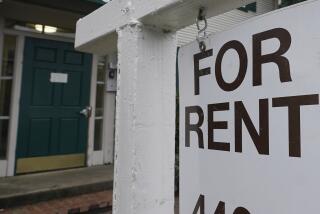SOUTHERN CALIFORNIA Job Market : PART TWO: GETTING AHEAD : Discrimination : Subtle cases still abound
When Michael K. Smith got a job unloading trucks for a Pepsi-Cola distributorship in Jacksonville, N.C., probably the last thing on his mind was suing the company.
But Smith said he noticed that certain work rules applied only to helpers such as himself, who were black. For one thing, Smith said, helpers were not allowed to use forklifts. But drivers were, and the drivers were white. Helpers had to park their cars away from driversâ cars. And helpers were not allowed to use a vending machine in the office unless they were accompanied by drivers.
Smith complained to the Equal Employment Opportunity Commission, the federal agency charged with enforcing laws against job discrimination because of race, color, religion, sex, age, national origin or pregnancy.
The EEOC became convinced that Smith and other helpers were being discriminated against because they were black. Company officials, who vigorously deny discriminating, fired Smith, claiming he was absent too much. Then the EEOC brought a suit that is pending against the company, contending that the firing was illegal retaliation for Smithâs complaint.
Twenty-three years after passage of the civil rights act that spawned the EEOC, Smithâs case stands out as atypical because it alleges blatant discrimination.
âWould you believe?â began an EEOC spokeswoman in describing the allegations. âI mean, this is going on in 1986, 1987?â
The vast majority of the nearly 120,000 complaints filed with the EEOC and its 45 sister state agencies last year involved far more subtle charges.
âThe âCâmon, get out of here. Youâre black. Weâre not going to hire you.â That just is not going to happen in 1987,â said Michael J. Shelley, chairman of the labor and employment law section of the State Bar of California. âAt least not that often. To the extent that discrimination is going on, itâs much more subtle and much more carefully shielded.â
In fact, discrimination has gotten so subtle that âa lot of the time people canât tell when theyâre being discriminated against,â said EEOC spokeswoman Renee Devine.
This is particularly true for black, female and even aging white male executives passed over for promotion, experts said. Although they may suspect they have been discriminated against, not many of these executives complain. They may conclude that it is not worth it: that complaining would lead to being passed over for future promotions and pay raises.
Officials of EEOC and its California counterpart, the state Department of Fair Employment and Housing, are aware of the danger of retaliation, although it is prohibited by law. But they encourage anyone who suspects discrimination to pursue the matter.
âIf you have even the slightest suspicion, do something about it,â said Carol Schiller, who is in charge of enforcement in Southern California for the state fair employment agency.
More and more people are. Even if job discrimination tends to be subtle, the number of complaints has increased to more than 119,000 last year from 92,000 in 1982.
Schiller said she has noted a change in who complains, however. A decade ago, racial discrimination cases accounted for 46% of the California agencyâs caseload. Now they account for 23%. Ten years ago, sex discrimination cases were 23% of the agencyâs caseload. Today they are 42%. Age discrimination allegations are also on the rise.
Nearly half of all complaints are found to be without merit. Experts attribute this mainly to an unfounded suspicion by many complainants that their membership in a legally protected class--their being black, or over 40, for instance--was the reason they received adverse treatment.
âA lot of people do not understand that the employment discrimination laws do not protect them against unfair actions, as such,â said Los Angeles lawyer Paul Grossman, co-author of a leading textbook on job discrimination law. âIt only protects them against adverse actions that occur because of their protected status.â
If you believe you have been discriminated against because you are a member of a protected group, you first have to decide where to take your complaint.
Grossman, who represents management in discrimination cases, suggests trying the affirmative action or personnel department of your firm, if it has one. âMost companies want to do the right thing, both in terms of running a good personnel operation and in terms of avoiding legal liability,â he said.
But sometimes the problem lies in personnel. The EEOCâs Devine offered an example: A job interviewer asks, â âAre you married? Do you have kids?â You should ask yourself: âWhat is the purpose of asking those questions? Does this really have any relation to my ability to do the job?â If it has nothing to do with ability to do the job, then it shouldnât be asked.â
If you go outside your company for help, you need to choose either the EEOC or the state fair employment agency. Officials of both agencies say they will investigate any complaint, whether or not you have hard evidence. But there are some important differences in the agenciesâ mandates.
California law, for example, goes beyond federal law to protect workers who have been discriminated against because of their medical conditions, including physical disabilities, or their marital status.
For technical reasons important to your later right to sue, be sure to get to one of the agencies within 240 days of the discriminatory act.
You can sue in state or federal court, regardless of which agency you go to and regardless of what the agency thinks of your claim, experts said. But the courts will not hear your lawsuit unless you have gone to an agency first.
The agenciesâ usual approach is to try to settle the problem by negotiating with your employer.
If this is unsatisfactory, you can always seek out a private lawyer. Your local bar association might be helpful.
You have to decide whether to pursue your claim in state or federal court. Under federal law, a claimant can only win back wages and attorneyâs fees. State law allows unlimited awards for pain, suffering and humiliation and to punish the employer.
Your employer will probably claim he had a legitimate business reason for taking the action that you term discrimination. You have to show that his reason is a pretext.
âThe smoking gun is the best evidence,â said Orange County employment lawyer William M. Crosby, âwhere (in an age discrimination case, for example) the supervisors were heard to have said, âWe want to get rid of the old fogies around there.â But most of the time you donât have that. Youâve got to prove it on circumstantial evidence.â
More to Read
Inside the business of entertainment
The Wide Shot brings you news, analysis and insights on everything from streaming wars to production â and what it all means for the future.
You may occasionally receive promotional content from the Los Angeles Times.






